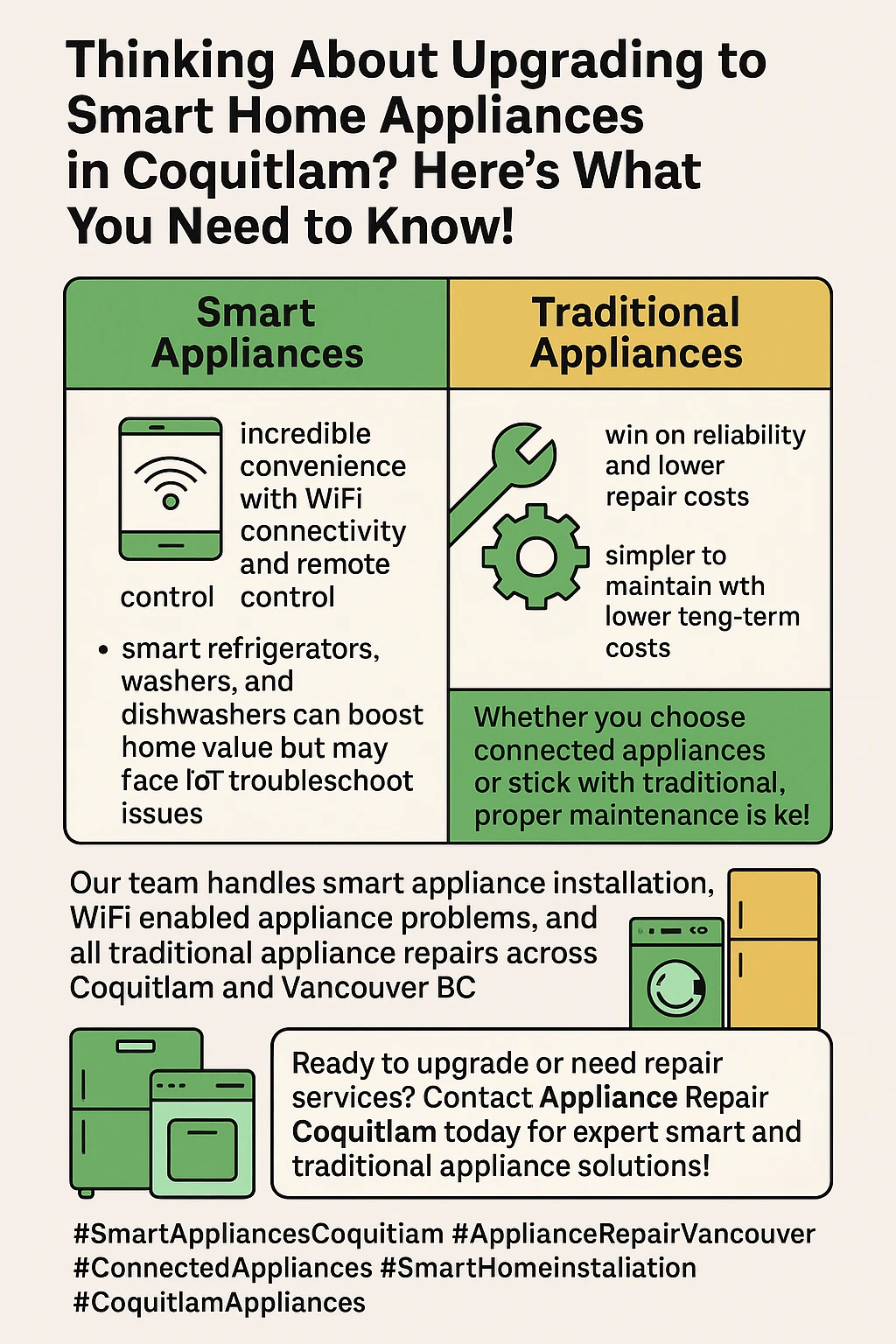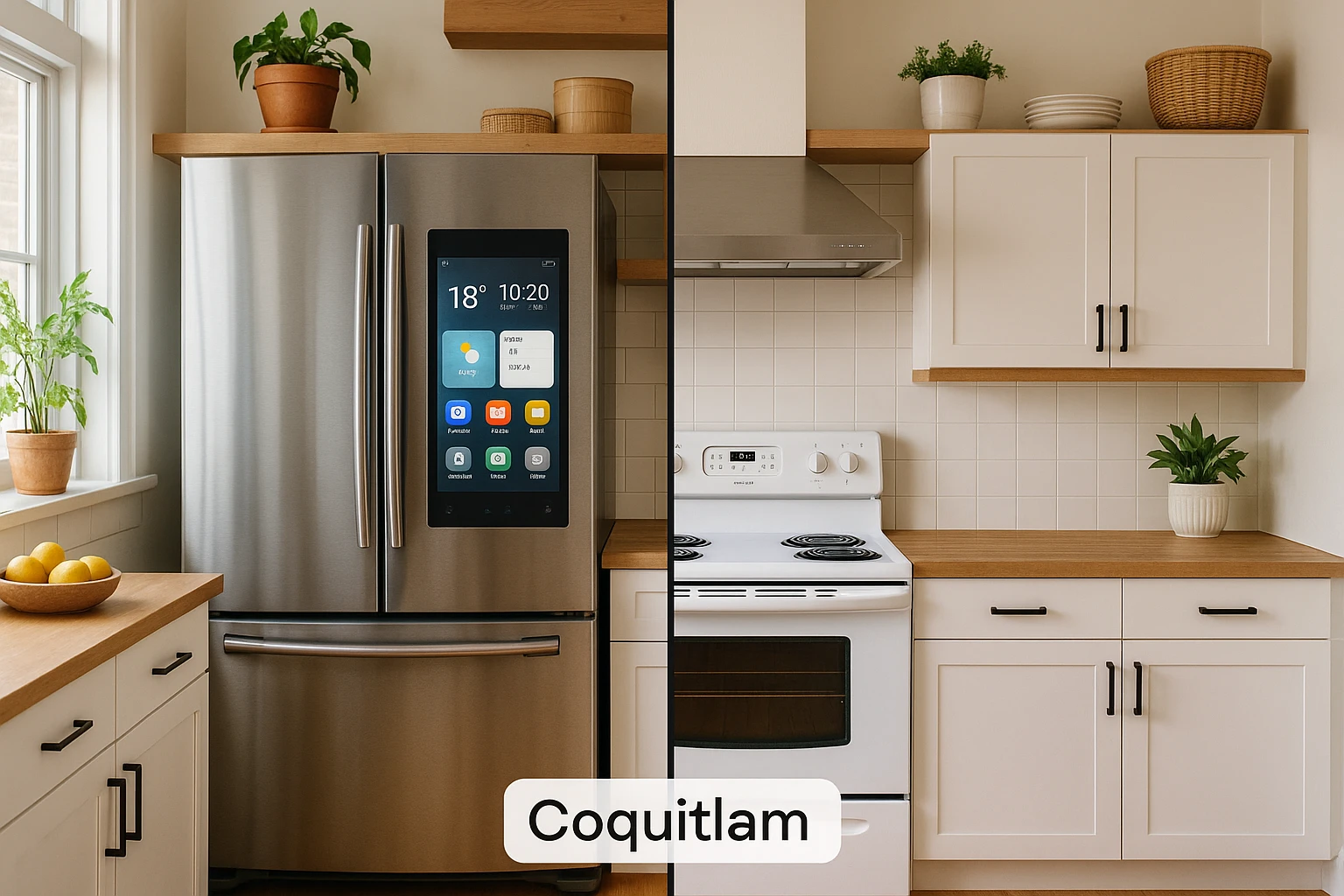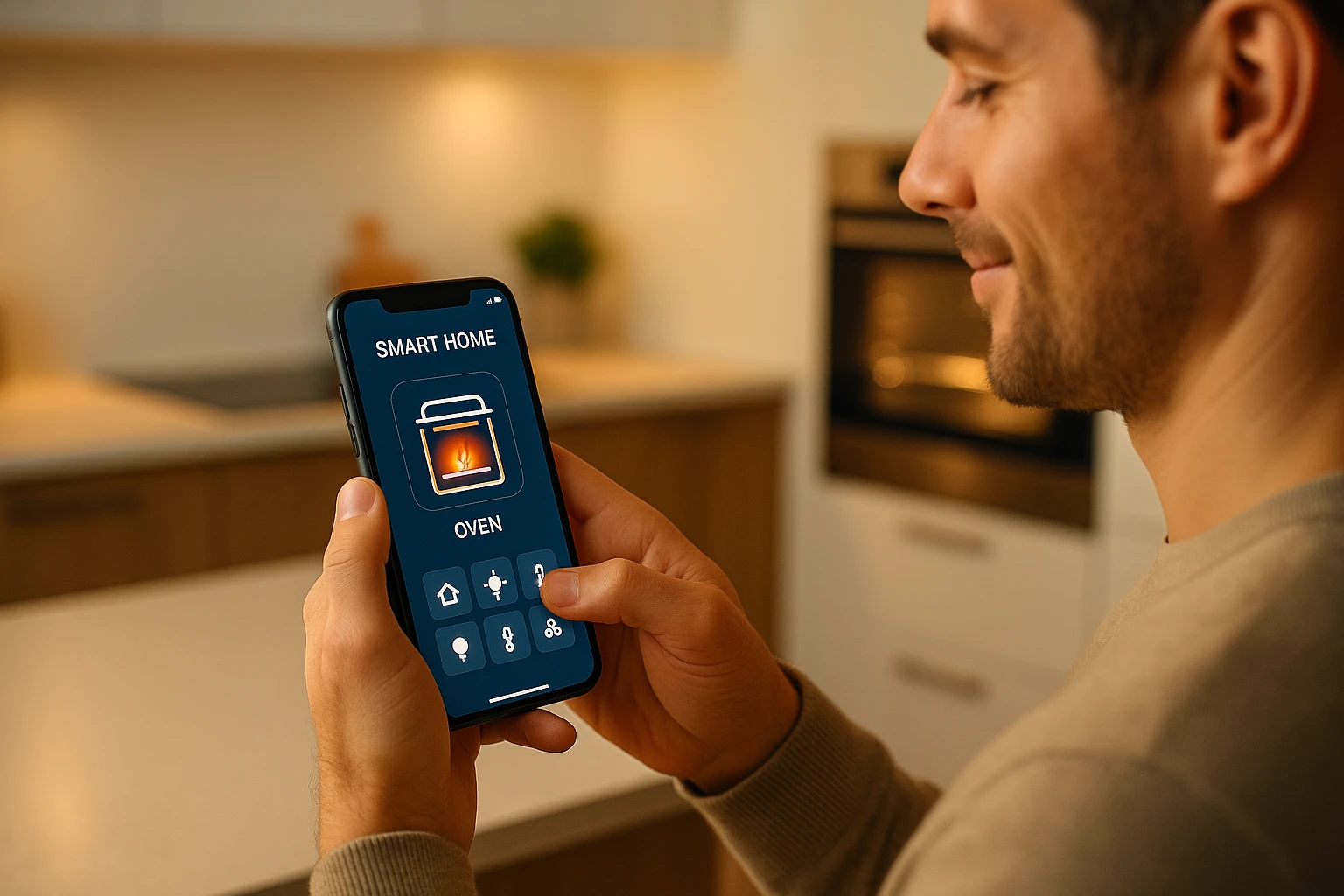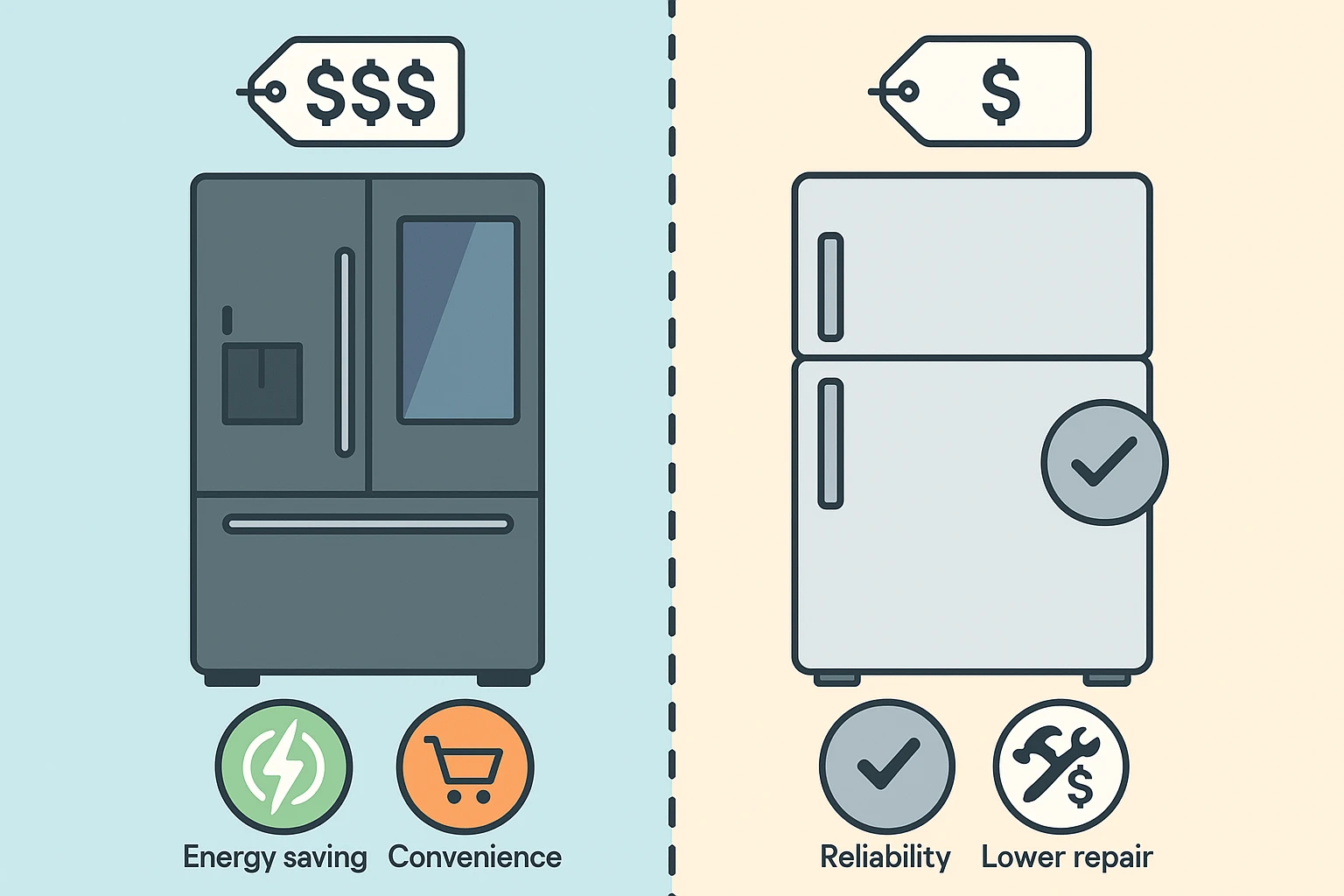Thinking about upgrading to smart appliances but wondering if they’re worth the investment? Let’s explore what Coquitlam homeowners should know about making the switch from traditional to smart technology before diving into this game-changing upgrade. Picture this: you’re rushing to get dinner ready after a long day at work, and you realize you forgot to preheat the oven. With smart appliances, you could have started that process from your car on the way home! But before you get swept up in the tech excitement, there’s a lot more to consider than just cool features. Smart appliances are basically the overachievers of the appliance world – they connect to your Wi-Fi, sync with your smartphone, and can even learn your habits to make life easier. Traditional appliances, on the other hand, are like that reliable friend who always shows up when needed – simple, dependable, and without any fuss. The decision between smart and traditional appliances isn’t just about keeping up with technology trends. It’s about finding the right balance between convenience, cost, and practicality for your specific lifestyle. Some Coquitlam families thrive with high-tech solutions that streamline their busy schedules, while others prefer straightforward appliances that simply do their job well without any digital complications.
Key Outtakes:
- Smart appliances offer convenience features like remote control and energy monitoring, but come with higher upfront costs and potential connectivity issues
- Traditional appliances provide reliable performance with simpler maintenance needs and lower initial investment
- Energy efficiency varies by model rather than technology type, with both smart and traditional options offering energy-saving features
- Repair complexity differs significantly between smart and traditional models, affecting long-term maintenance costs
- The best choice depends on your budget, tech comfort level, and specific household needs rather than following trends

Understanding Smart Appliances and Their Technology

Smart appliances are essentially traditional appliances that have been given a digital brain and internet connection. They use sensors, Wi-Fi connectivity, and smartphone apps to provide features that go way beyond basic operation. Think of them as the difference between a regular phone and a smartphone – both make calls, but one does so much more. The technology behind these appliances includes internal sensors that monitor performance, detect problems early, and adjust settings automatically. Many smart refrigerators can track your grocery inventory using internal cameras, suggest recipes based on what’s inside, and even create shopping lists. Smart ovens can be preheated remotely, monitor cooking progress through built-in cameras, and send notifications when your meal is ready. These advanced features represent a significant leap from the simple on-off switches of traditional models. What makes smart appliances truly “smart” is their ability to learn from your usage patterns. A smart washing machine might remember that you usually do laundry on Sunday evenings and suggest the most efficient wash cycle based on your typical load size. Smart dishwashers can detect how dirty your dishes are and adjust water usage accordingly. This learning capability means the appliances become more efficient and useful over time, adapting to your specific household’s needs and preferences.
The Smart Appliance Advantage

The transition from discussing basic technology to exploring real benefits shows how smart features translate into daily convenience. Smart appliances shine brightest when it comes to time-saving and convenience features that busy Coquitlam families genuinely appreciate. Remote control capabilities top the list of popular smart features. You can start your dishwasher from bed, check if you remembered to turn off the oven while at work, or begin a load of laundry before heading home from errands. This level of control eliminates those nagging worries about whether you left something running and gives you flexibility in managing household tasks around your schedule. Energy monitoring represents another major advantage that appeals to cost-conscious homeowners. Smart appliances provide detailed feedback about energy consumption, helping you identify which appliances use the most electricity and when. Some models can even automatically adjust their operation during peak electricity rate hours to save money on utility bills. This transparency allows you to make informed decisions about usage patterns and potentially reduce monthly expenses. Built-in diagnostic capabilities set smart appliances apart from traditional models in terms of maintenance management. Instead of wondering why your refrigerator sounds different or your washing machine isn’t cleaning as well, smart appliances can identify specific problems and alert you before they become major issues. Many can even order replacement parts automatically or schedule service appointments through their connected apps. The convenience factor extends to grocery management and meal planning through smart refrigerators that track expiration dates and suggest recipes. Some models can create shopping lists based on what’s running low and even place orders for frequently used items. This level of automation can significantly reduce food waste and simplify meal planning for busy families. Integration with other smart home systems creates a seamless connected experience. Smart appliances can communicate with voice assistants, security systems, and even solar panel systems to optimize energy usage. This interconnectedness means your appliances work together as part of a larger home automation ecosystem rather than operating as isolated units.
Traditional Appliances: Tried and True Reliability
Moving from high-tech features to fundamental reliability brings us to why traditional appliances continue to hold strong appeal for many Coquitlam homeowners. Sometimes the best technology is the technology that just works without overthinking things. Simplicity remains the biggest selling point for traditional appliances. They focus on doing one job exceptionally well without the complexity of multiple features and connectivity requirements. A traditional refrigerator keeps food cold, a traditional oven bakes and roasts, and a traditional washing machine cleans clothes – no apps, no Wi-Fi passwords, and no troubleshooting connection issues. This straightforward approach appeals to homeowners who prefer appliances that operate independently of internet service or smartphone compatibility. Reliability in traditional appliances comes from decades of refined mechanical engineering. These appliances use proven technology with fewer electronic components that could potentially fail. Many traditional models can operate for 15-20 years with basic maintenance, developing a track record of dependable performance that homeowners can count on. The mechanical controls and simpler internal systems mean fewer things can go wrong compared to their digitally complex counterparts. Cost advantages extend beyond the initial purchase price. Traditional appliances typically cost 30-50% less than comparable smart models, making them accessible for budget-conscious families or first-time homeowners. The savings continue with lower repair costs since fixing mechanical issues generally costs less than diagnosing and repairing complex electronic systems. Local appliance repair technicians are also more familiar with traditional appliance repairs, making service more readily available and affordable. Maintenance simplicity allows most homeowners to handle basic upkeep without professional help. Cleaning lint filters, changing water filters, and basic troubleshooting can usually be accomplished without consulting smartphone apps or online tutorials. This hands-on approach gives homeowners more control over their appliances’ care and extends their operational lifespan through proper maintenance. Energy efficiency in modern traditional appliances rivals many smart models. Today’s traditional appliances meet strict Energy Star standards and incorporate efficient motors, improved insulation, and optimized mechanical systems. While they may not provide detailed energy consumption data like smart models, they deliver excellent efficiency through refined engineering rather than digital optimization.
Cost Comparison and Long-Term Value

Understanding the true cost difference between smart and traditional appliances requires looking beyond sticker prices to consider total ownership costs over time. This comprehensive analysis helps Coquitlam homeowners make financially sound decisions. Initial purchase prices show the most obvious difference between appliance types. Smart appliances typically cost $500-2000 more than comparable traditional models, depending on the appliance type and feature set. A basic traditional refrigerator might cost $800-1500, while smart versions start around $2000 and can exceed $4000 for premium models. This upfront investment represents a significant budget consideration for most families. Installation costs can vary significantly between appliance types. Traditional appliances usually require standard electrical and plumbing connections that most homes already accommodate. Smart appliances might need upgraded electrical service, improved Wi-Fi coverage, or professional setup to integrate with home networks. These additional requirements can add $200-500 to installation costs, depending on your home’s current infrastructure. Operating costs present a more complex comparison. Smart appliances often provide better energy efficiency through optimized operation and user behavior insights. However, they also consume additional electricity for Wi-Fi connectivity, touchscreen displays, and internal computers. The net energy savings depend heavily on usage patterns and how effectively homeowners utilize the smart features to reduce consumption. Repair and maintenance costs represent a significant long-term consideration. Traditional appliances benefit from widespread repair knowledge among technicians and readily available replacement parts. Smart appliances require specialized diagnostic equipment and technicians trained in both mechanical and electronic systems. Repair costs for smart appliances average 40-60% higher than traditional models, and some complex electronic failures might require complete control board replacements costing $400-800. Longevity expectations differ between appliance types. Traditional appliances often operate reliably for 15-20 years with proper maintenance. Smart appliances face additional challenges from rapidly evolving technology that might make older models obsolete or unsupported after 7-10 years. Software updates might eventually stop, and connectivity standards could change, potentially limiting functionality even when mechanical components remain sound.
Repair and Maintenance Considerations
The transition from analyzing costs to examining practical maintenance reality reveals important differences that affect daily ownership experiences. Repair complexity represents one of the most significant distinctions between smart and traditional appliances. Traditional appliance repairs benefit from decades of accumulated technician experience and established troubleshooting procedures. Local repair services typically stock common replacement parts and can diagnose problems through visual inspection and basic testing. Most mechanical failures involve straightforward component replacements like motors, heating elements, or control switches that cost $50-200 for parts plus labor. Smart appliance diagnostics require specialized knowledge combining mechanical, electrical, and software troubleshooting skills. Technicians need access to proprietary diagnostic software and often must connect remotely to manufacturer support systems for complex problems. This specialized requirement limits the number of qualified repair services and can extend repair timelines while parts are ordered or software issues are resolved with manufacturer support. DIY maintenance possibilities differ dramatically between appliance types. Traditional appliances allow homeowners to perform many basic repairs and maintenance tasks using standard tools and readily available parts. Online tutorials and repair manuals provide step-by-step guidance for common issues. Smart appliances discourage DIY repairs due to complex electronic systems and warranty restrictions that void coverage if unauthorized repairs are attempted. Preventive maintenance requirements vary between traditional and smart models. Traditional appliances need regular cleaning, filter changes, and basic mechanical adjustments that homeowners can typically handle. Smart appliances require software updates, network security maintenance, and periodic recalibration of sensors in addition to traditional mechanical care. Neglecting digital maintenance can lead to reduced functionality or security vulnerabilities. Parts availability represents a long-term consideration for both appliance types. Traditional appliance parts remain available for decades due to standardized components and aftermarket manufacturing. Smart appliance parts depend on individual manufacturers continuing support, and proprietary electronic components might become unavailable when production ends. This difference significantly affects the practical lifespan and repairability of aging appliances. Professional service relationships also change with smart appliances. Traditional appliance owners can choose from multiple local repair services and compare prices for most repairs. Smart appliance owners often depend on manufacturer-approved service providers who charge premium rates for specialized knowledge and diagnostic equipment access.
Energy Efficiency: Smart vs Traditional
Energy performance represents a crucial factor for environmentally conscious Coquitlam homeowners looking to reduce their carbon footprint and utility costs. The reality of energy efficiency differences between smart and traditional appliances is more nuanced than marketing materials might suggest. Both smart and traditional appliances must meet identical Energy Star certification standards, meaning baseline efficiency requirements are the same regardless of technology type. The difference lies in how this efficiency is achieved and maintained over time. Traditional appliances achieve efficiency through refined mechanical designs, improved insulation, and optimized component engineering. Smart appliances add digital features that can enhance efficiency through operational intelligence and user behavior optimization. Smart appliances excel at providing detailed energy consumption feedback that helps users identify wasteful habits and adjust behavior accordingly. Real-time monitoring shows exactly how much electricity each appliance uses during different operating modes, peak usage times, and even standby power consumption. This transparency enables informed decisions about usage patterns that can reduce overall energy consumption by 10-15% through behavior changes alone’. Automated optimization features in smart appliances can improve efficiency beyond what manual operation achieves. Smart dishwashers adjust water temperature and cycle length based on soil sensors, while smart dryers stop automatically when clothes reach optimal dryness rather than running for preset times. Smart refrigerators adjust cooling cycles based on usage patterns and ambient temperature changes, maintaining optimal freshness while minimizing energy waste. However, smart connectivity features consume additional electricity that partially offsets efficiency gains. Wi-Fi modules, touchscreen displays, internal cameras, and always-on computer systems add 20-50 watts of continuous power consumption. This baseline consumption means smart appliances use more electricity even when not actively operating, which can negate efficiency benefits for light-usage households. Load management capabilities in smart appliances can provide significant savings for homes with time-of-use electricity rates. These appliances can automatically delay operation until off-peak hours when electricity costs less, or coordinate with solar panel systems to run during peak generation periods. Traditional appliances require manual scheduling to achieve similar benefits.
Integration with Smart Home Systems
The evolution from individual appliance benefits to whole-home integration reveals how smart appliances can become part of a larger connected ecosystem. For Coquitlam homeowners already investing in smart home technology, appliance integration offers compelling advantages beyond individual unit benefits. Voice control integration with systems like Amazon Alexa, Google Assistant, or Apple HomeKit allows hands-free appliance operation that’s particularly valuable during cooking and cleaning tasks. You can preheat the oven while your hands are busy with meal prep, start the dishwasher after dinner without stopping your cleanup routine, or check laundry status while folding clothes in another room. This seamless control integration makes smart appliances feel like natural extensions of your smart home ecosystem. Automation routines can coordinate multiple smart appliances to work together efficiently. Morning routines might simultaneously start the coffee maker, begin warming the oven for breakfast, and start a load of laundry. Evening routines could automatically run the dishwasher after dinner, set the refrigerator to energy-saving mode, and prepare the washing machine for the next day’s schedule. These coordinated operations reduce energy peaks and optimize household efficiency. Security system integration allows smart appliances to enhance home safety beyond their primary functions. Smart ovens can automatically shut off when security systems are armed, reducing fire risks when no one’s home. Smart water heaters can detect unusual usage patterns that might indicate leaks or security breaches. This integrated approach provides an additional layer of home protection through appliance monitoring. Energy management becomes sophisticated when smart appliances coordinate with solar panels, battery storage systems, and utility smart meters. Appliances can automatically prioritize operation during solar generation peaks, defer energy-intensive cycles during grid peak hours, and coordinate with battery systems to maximize renewable energy usage. This level of integration can significantly reduce utility costs and environmental impact. However, integration complexity can become overwhelming for some homeowners. Managing multiple apps, maintaining network security, and troubleshooting connectivity issues between different smart devices requires ongoing technical attention. The convenience benefits must be weighed against the time investment needed to maintain and optimize integrated smart home systems.
Frequently Asked Questions
Do smart appliances actually save money on energy bills?
Smart appliances can reduce energy costs through behavior optimization and automated efficiency features, but the savings vary significantly based on usage patterns and electricity rates. Most households see 5-15% energy savings through better usage habits enabled by real-time consumption monitoring. However, smart appliances also consume additional electricity for connectivity features, which can offset savings for low-usage households. The biggest financial benefits come from homes with time-of-use electricity rates where smart appliances can automatically shift operation to lower-cost periods.
What happens to smart appliances when the internet goes down?
Most smart appliances maintain basic functionality during internet outages, but smart features become unavailable until connectivity is restored. Your smart refrigerator will continue cooling food, smart ovens will still bake using manual controls, and smart washing machines will complete running cycles. However, you’ll lose remote monitoring, automatic notifications, energy tracking, and integration with other smart home devices until internet service returns. Essential appliance functions are designed to work independently of network connectivity for reliability.
Are smart appliances harder to repair than traditional ones?
Smart appliances typically require more complex repairs due to their electronic components and software systems. Repair costs average 40-60% higher than traditional appliances because technicians need specialized training and diagnostic equipment. Finding qualified repair services can be challenging since many local technicians lack experience with smart appliance technology. Additionally, some repairs require manufacturer software access or proprietary parts that extend repair timelines. Traditional appliances benefit from widespread repair knowledge and readily available parts that keep service simple and affordable.
Wrapping Up
The choice between smart and traditional appliances ultimately comes down to matching technology with your lifestyle rather than following the latest trends. Smart appliances offer genuine convenience for tech-savvy families who value remote control, energy monitoring, and integration with existing smart home systems. The ability to manage appliances remotely, receive maintenance alerts, and optimize energy usage can provide real value for busy households willing to invest in the technology. However, these benefits come with higher upfront costs, increased repair complexity, and ongoing maintenance requirements that some homeowners prefer to avoid. Traditional appliances continue to excel at reliable, straightforward operation without the complexity of connectivity and software management. They offer proven longevity, simpler repairs, and lower total ownership costs that appeal to budget-conscious homeowners and those who prefer uncomplicated technology. Modern traditional appliances still provide excellent energy efficiency and performance without requiring network setup or smartphone apps to operate effectively. For Coquitlam homeowners making this decision, consider your comfort level with technology, budget for both purchase and long-term maintenance, and realistic assessment of which features you’ll actually use regularly. The best appliance choice is the one that fits your household’s specific needs and preferences rather than the one with the most impressive feature list. Whether you choose smart or traditional appliances, focus on quality brands with good local service support to ensure years of reliable performance in your home.